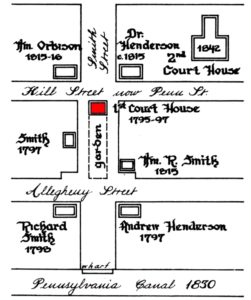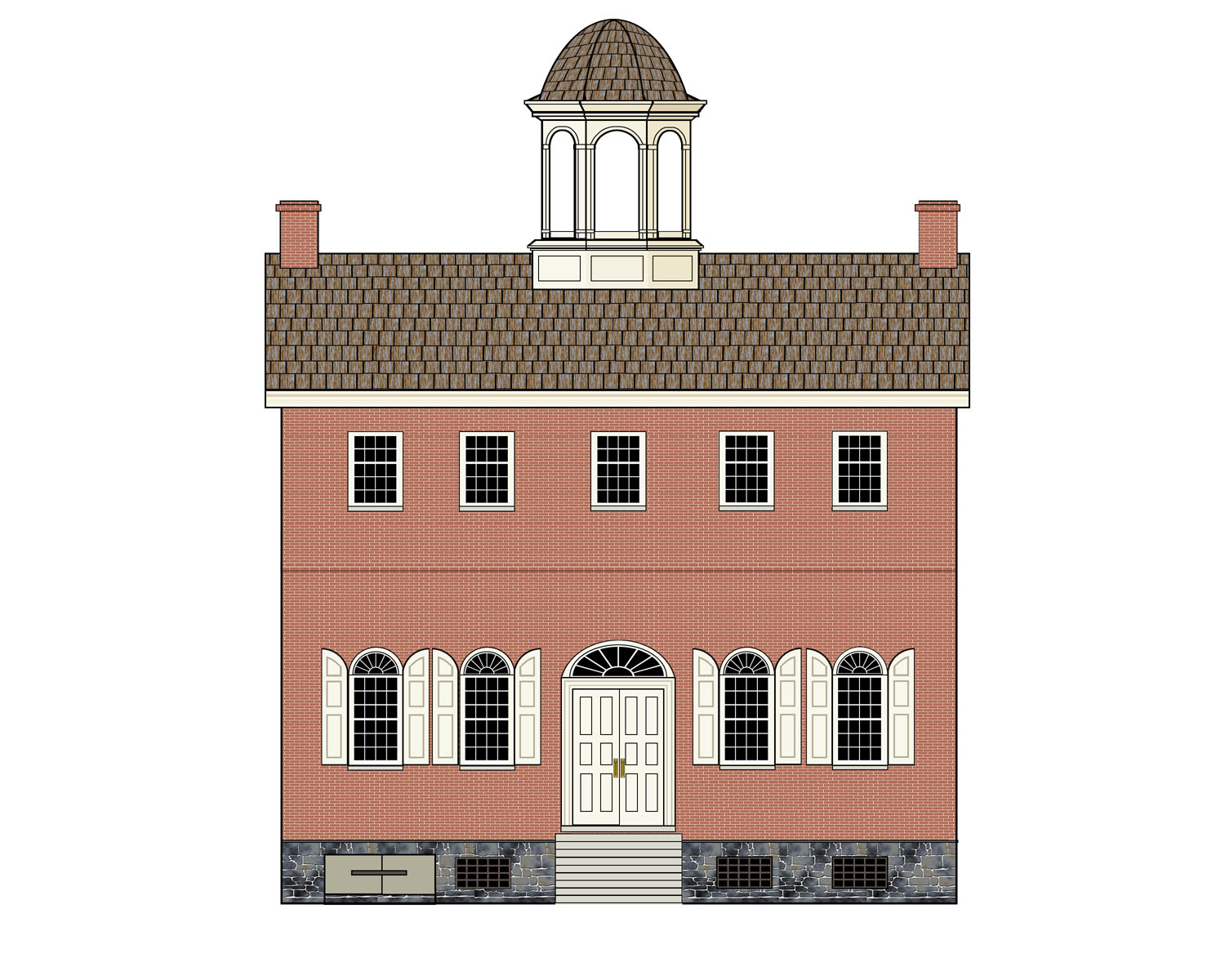FIRST HUNTINGDON COUNTY COURTHOUSE
DETAILS OF CONSTRUCTION
AS PROPOSED BY THE COUNTY COMMISSIONERS
[Transcribed from manuscript documents preserved at the present Courthouse.
Date is apparently Monday, 4 August, 1794.]

44’ long (E-W axis) and 36’ wide (N-S axis), brick with stone foundation.
To be set 30’ back from Hill Street, in the middle of Smith St., which the Commissioners note Rev. William Smith has agreed to widen from 90’ to 104’.
Ground Floor: 2 arched rooms, 18’ in depth with an entry 8 feet wide between them, to extend under the whole front next Allegheny St. with a good chimney in each at least 2’6”. With 2 windows in front of each, 24 lights, 8”x10” (presumably 2 sashes of 12 lights each – 4 wide and 3 high). The entry door to be paneled and lined (in other words, double thickness – we have an old door made like this) with an arched window of proper size over it to light the passage. The office doors to open from the entry, to be paneled with substantial locks to open outwards & iron doors with latches to open inwards, with paneled and lined window shutters & inside of the others iron ones. Entry and floors paved with brick or tile, the [ceiling & walls – hard to read] well plastered. The foundation of the back part to be even with the front offices & that part fitted out & properly lighted as a cellar with the doors outside next Hill Street (as an outside cellar-way). Cellar to have 3 windows properly grated with iron. Door to descend with stone steps well fitted with folding doors with an iron bar across & lock. The walls on each side of the passage 18” thick, the end walls of the offices 3’ thick, the front next to Allegheny to be brick from within 2’ of the ground.
The second story 18” walls, 16’ from floor to ceiling, sleepers well squared 12”, to rest on the middle wall dividing the offices from the cellar. To have double paneled door fronting Hill Street with 4 windows in front on Hill Street and 5 on Allegheny St. and 2 in each end – all 24 lights 8”x10” with shutters and sash as in the lower ones glassed and painted white with black putty. Door frame double architrave, windows single, shutters paneled and well lined as well as doors and painted white. Good irons to fasten the windows open and bolts to shut them, the hinges – both door and windows to be strong and well hung, all the staples to go through the frames and to be clenched and the hinge well riveted. A handsome arched window over the door and over each window. Floor well laid with quartered stuff, pitch or yellow pine, 1 ½ “ thick, one side planed and grooved. The joists 11 x 3”, framed into a girder to be supported by 2 pillars turned handsomely and finished in the Tuscan order and painted white. A chimney in each end, 3’ at the brick wall. The bench to be erected on the side next Allegheny Street, 5’ from the floor to the floor of the bench with good seats and ? banisters, painted white. A good bar table & boxes for Grand and Traverse jurys & criminal bar erected 12” above the level of the floor, banisters, and painted white. The bench 18 or 20 feet long & bar & boxes in a circular form. A plain seat 3’ high with a step 1’ fit all around the parts of the wall not taken up by chimneys or bench. The walls to be well plastered & ceiling lathed & plastered. A convenient seat for cryer.
Stairs, to ascend to the right hand of the door to wind from a platform in the corner, to be neatly finished with banisters, painted white. The width & elevation to be in proportion to the other parts of the building.
The upper story 10’ high, windows glazed, painted & finished in the same manner (except shutters) as the lower story, to be 20 lights 8”x10” (8 lights over 12). Partitions lathed & plastered, floor planed, laid with good quartered stuff, pitch or yellow pine, 1 ¼” & grooved. One room the whole length on the side towards Allegheny Street 16’ wide & chimneys in one end 2’6”. A middle passage from that room to the back side next Hill Street 8’ wide, the residue to be divided into 2 rooms as conveniently as possible with a chimney 2 ½’ in one of them. The garret joists to be framed into the girder which is to be supported by 2 good octagonal pillars set over the heads of those below. The underside of the garret floor and joists planed & beaded. The walls & chimneys as well as partitions of this story plastered. A small flight of stairs to the garret in the most convenient plan.
The roof white pine joint shingles not more than 11” to the weather & 3’ long, well put on good wall plate rafters & painted Spanish Brown. A handsome cornish (cornice) & moulding above & below the boxes to be painted white. Tin spouts for the water behind and before, carried down to the ground by 2 pipes. A cupola of a size proportioned to the size of the building, staunch well-made & sufficient to support a bell of the same proportion, well covered, painted white & ornamented in uniform with the other parts of the building.
Signed by Ludwig Sell, Benjamin Elliot, Andrew Henderson, and George Ashman.
There are two proposals from contractors, one with little sketches (from John Cadwallader), but not the one chosen for the contract, which was with John Blair. Blair’s proposal says he will build a courthouse according to the plan laid down by the Commissioners “except such part as mentions the cellar walls to be level with the front and which in lieu thereof we propose to make 7 feet to the first floor.” Proposes to have work on offices and courtroom complete by November Term 1796 and the remainder by April 1797.
Below is Fred Lang’s interpretation of the Commissioners’ description of the front of the Courthouse, on Penn or Hill Street, as it was called then.

